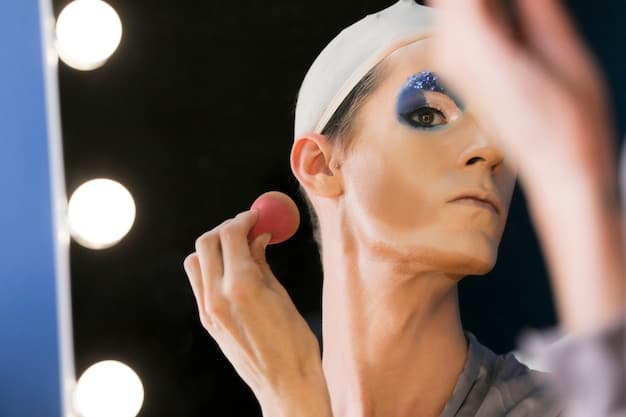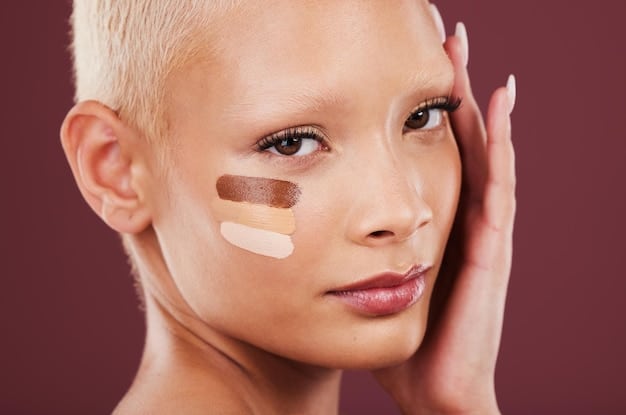How to Match Your Foundation to Your Skin Tone: A 2025 Guide

Achieving a perfect foundation match is crucial for a flawless complexion, evolving in 2025 with advanced methods focusing on undertone identification, digital tools, and ethical product choices to ensure seamless integration with your natural skin.
In the evolving world of beauty, mastering How to Match Your Foundation to Your Skin Tone: A 2025 Guide is more critical than ever for achieving a truly natural and radiant look. The right foundation doesn’t just cover; it enhances, unifies, and creates a canvas that feels like a second skin.
Understanding Your Skin’s Unique Profile in 2025
The first step to a perfect foundation match is deeply understanding your skin’s characteristics. This isn’t just about surface color; it involves recognizing your undertone, intensity, and texture, all of which play a pivotal role in how foundation settles and appears throughout the day. In 2025, personalized skin analysis goes beyond basic visual checks, incorporating more refined methods.
Identifying your undertone is paramount. It determines whether your skin has cool (pink, red, bluish), warm (yellow, peach, golden), or neutral (a mix of both) hues. Ignoring this can lead to an ashy or overly orange appearance, even if the shade intensity seems correct. New digital tools and in-store diagnostics are making this process more precise.
The Science of Undertones and Overtones
Understanding your undertone helps you select foundations that truly blend rather than sitting on top of your skin. Overtones are the surface color, which can change due to sun exposure or environmental factors, but the undertone remains constant.
- Cool Undertones: Veins appear purple or blue; skin may burn easily in the sun. Foundation options lean towards pink, red, or blue bases.
- Warm Undertones: Veins appear green; skin may tan easily. Foundations are often yellow, peach, or golden-based.
- Neutral Undertones: Veins are a mix of blue/green; skin doesn’t lean strongly warm or cool. Foundations with a balanced mix of pigments are ideal.
Beyond undertones, consider your skin’s intensity—how light or deep your complexion is. This is usually more straightforward to determine visually, ranging from fair to deep. However, subtle variations within these categories require careful testing. Finally, skin texture—oily, dry, combination, or sensitive—influences the foundation formula you choose, affecting longevity and finish.
Advanced Skin Analysis Methods
The beauty industry in 2025 is leveraging technology to simplify this complex process. Many brands now offer in-store skin analysis devices that scan your skin to identify both undertone and intensity. Online tools also use AI to analyze uploaded photos, providing surprisingly accurate recommendations.
These advanced methods aim to remove the guesswork, providing a data-driven approach to finding your ideal match. While a human eye remains valuable, technology offers an objective starting point, especially for those new to makeup or struggling with traditional matching techniques.
Ultimately, a deep understanding of these elements provides the bedrock for selecting a foundation that looks truly natural, rather than merely covering the skin. It’s about enhancing what’s already there, creating a harmonious and polished look, which is the cornerstone of effective foundation application in 2025.
Navigating Foundation Formulas and Finishes in 2025
Once you understand your skin’s profile, the next step is selecting the right foundation formula and finish. The market in 2025 offers an extensive array, each designed to address specific skin concerns and desired aesthetics. Your choice profoundly impacts how the foundation looks, feels, and performs throughout the day.
Formulas for Every Skin Type
Foundation formulas are engineered to cater to different skin types, ensuring optimal wear and benefit. Modern formulations often incorporate skincare ingredients, blurring the lines between makeup and treatment.
- Liquid Foundations: Versatile and widely available, offering varying coverage from sheer to full. Best for most skin types, especially those seeking a natural finish.
- Cream Foundations: Thicker consistency, ideal for dry or mature skin, providing higher coverage and a dewy finish. Often enriched with hydrating ingredients.
- Powder Foundations: Excellent for oily skin, providing a matte finish and helping to control shine. Can be applied wet or dry for varying coverage.
- Serum Foundations: Lightweight, often hydrating, and infused with active skincare ingredients. Perfect for those who prefer a sheer, natural look and skincare benefits.
- Stick Foundations: Convenient for on-the-go application and touch-ups, offering buildable coverage. Good for targeted application and concealing.
Each formula has its unique application method and wear characteristics. For instance, liquid foundations often require a brush or sponge for an even application, while powder foundations work best with a dense brush for buffing into the skin. Cream and stick foundations can be applied with fingers for a seamless blend.
Choosing the Right Finish
The finish of a foundation dictates its final appearance on the skin, ranging from incredibly luminous to completely matte. This choice is primarily driven by your skin type and desired aesthetic.
- Matte Finish: Ideal for oily or combination skin, minimizing shine and providing a velvety, often pore-blurring effect.
- Satin/Natural Finish: The most versatile, providing a soft glow without being overly dewy or matte. Suitable for most skin types looking for a balanced appearance.
- Dewy/Radiant Finish: Best for dry or mature skin, providing a luminous, hydrated look. Can enhance a healthy glow and minimize the appearance of fine lines.
- Luminous/Glowy Finish: Even more radiant than dewy, giving a truly glowing effect. Popular for those seeking a youthful, vibrant complexion.
In 2025, many brands are focusing on “skin-like” finishes that mimic the natural texture of healthy skin, offering coverage without a heavy feel. The best way to determine the right formula and finish is through experimentation and considering your daily activities and environment. A foundation that looks great in natural light might appear different under artificial office lighting, highlighting the importance of thorough testing.
The Art of Swatching: Beyond the Jawline in 2025
Swatching foundation is crucial, and the traditional method of applying it along the jawline has evolved for 2025. While the jawline still offers a good starting point, a comprehensive swatch test now involves multiple areas of the face and neck, under varying lighting conditions, to ensure a truly seamless match.

Strategic Swatching Locations
The jawline is a decent initial testing spot because it allows you to compare the foundation to both your face and neck, bridging visible skin tones. However, our faces often have variations in color due to sun exposure, redness, or hyperpigmentation. Therefore, it’s beneficial to swatch a small amount on these additional areas:
- Cheeks: Often reflects the true skin tone of the face.
- Forehead: Can be darker or lighter than the rest of the face.
- Neck/Décolletage: Crucial for ensuring the foundation blends seamlessly from face to body, avoiding a “floating head” effect.
- Inner Arm (for undertone check): While not for color matching, it’s a good spot to re-confirm your undertone without makeup.
Apply three to four shades that appear close to your skin tone. Instead of a thick line, blend a small dot of each shade into the skin. This allows you to see how the foundation interacts with your skin’s natural oils and undertones as it dries.
The Importance of Lighting
Lighting is perhaps the most critical factor in successful swatching. Stores often have harsh, artificial lighting that can distort colors, making a shade look perfect indoors but completely wrong once you’re outside. In 2025, this awareness leads to more purposeful testing:
- Natural Daylight: Always step outside or stand near a window to observe the foundation in natural light. This is the most accurate representation of how the foundation will look in everyday life.
- Indoor Lighting Variation: If possible, check the match under various indoor lighting conditions—fluorescent, incandescent, and LED—to see how it performs in different environments you frequent.
Allow the foundation to sit on your skin for at least 10-15 minutes before making a decision. Foundations can oxidize, meaning their color may deepen or change slightly as they interact with your skin’s oils and oxygen. This waiting period ensures you assess the true, settled color. A perfect match will virtually disappear into your skin, leaving no discernible line or patch.
The goal is for the foundation to melt into your skin, creating an imperceptible layer rather than a visible mask. This meticulous swatching process, beyond just the jawline and under varied lighting, ensures you purchase a foundation that truly enhances your complexion in every situation.
Leveraging Digital Tools and AI in 2025 for Foundation Matching
The landscape of foundation matching has been revolutionized by digital innovation. In 2025, artificial intelligence (AI) and augmented reality (AR) tools are not just novelties; they are integral components of the modern beauty shopping experience, offering unprecedented accuracy and convenience.
AI-Powered Shade Finders
Many beauty brands and retailers now offer sophisticated online shade finders. These tools utilize AI to analyze various inputs, from uploaded selfies to answers about your current foundation shade or even your general skin characteristics. The algorithms then cross-reference this data with their extensive product databases to suggest potential matches.
- Selfie Analysis: Users upload a clear, well-lit photo of their face. AI analyzes skin tone, undertone, and even subtle redness or pigmentation, recommending shades that are likely to blend seamlessly.
- Existing Product Matchers: If you know your shade in one brand, these tools can often find equivalent shades in other brands, simplifying the transition between product lines.
- Questionnaires: Simple quizzes guide users through questions about their skin’s appearance, reactivity to sunlight, and vein color to determine undertone and overall shade intensity.
While highly effective, it’s important to use these tools in well-lit environments, preferably natural light, and to provide the clearest possible inputs for the most accurate results. These tools excel at narrowing down options, making the in-store or at-home testing process much more efficient.
Augmented Reality (AR) Try-On Features
AR technology has transformed the virtual try-on experience. Using your smartphone or computer camera, you can virtually “try on” different foundation shades in real-time. This interactive experience allows you to see how various colors and even finishes appear on your skin without physically applying any product.
- Real-Time Visualization: AR overlays the foundation shade directly onto your live video feed, adapting to your facial movements and expressions.
- Filter Options: Some AR tools allow you to toggle between different lighting conditions or even simulate how the foundation looks with varying levels of coverage.
- Comparison Features: Many platforms enable side-by-side comparisons of multiple shades, making it easier to identify the most natural-looking option.
AR try-ons are particularly useful for exploring a wide range of shades quickly, especially for brands not readily available in physical stores. While AI and AR provide excellent guidance, they should be viewed as powerful preliminary steps. The final confirmation should always come from testing the actual product on your skin, ideally with a sample, to account for unique skin chemistry and oxidation.
Seasonal Adjustments and Adapting Your Foundation Routine in 2025
Your skin tone is not static; it responds to seasons, sun exposure, and even hormonal changes. In 2025, beauty routines embrace this fluidity, promoting adaptability in foundation matching rather than adherence to a single, year-round shade. Being prepared to adjust your foundation is key to maintaining a perfect match.
Seasonal Skin Tone Changes
Most people experience a slight shift in their skin tone throughout the year. During summer months, increased sun exposure (even with diligent SPF use) can lead to a subtle tan, causing your skin to deepen by one or two shades. Conversely, in winter, skin tends to lighten as sun exposure decreases.
Ignoring these changes can result in a visible demarcation line between your face and neck. To counteract this, consider having two foundation shades on hand: one for your lighter winter complexion and one for your slightly deeper summer tan. Alternatively, a common strategy is to purchase a foundation slightly darker than your winter shade and a slightly lighter one for summer, then mix them to create custom blends as needed.
Smart Mixing and Customization
The ability to mix shades offers the ultimate flexibility. Instead of buying multiple full-size bottles, consider:
- Duo-Shade Strategy: Purchase your primary winter shade and a summer shade that is one or two steps darker. Mix them in varying ratios on the back of your hand to create interim shades that perfectly match your skin as it transitions.
- Foundation Mixers/Adjusters: Some brands offer foundation adjusters—drops that can lighten, darken, or even adjust the undertone of your existing foundation. These are excellent for fine-tuning a shade without committing to a new bottle. Hue adjusters, for example, can add a touch of warmth or coolness if your undertone needs a slight tweak.
When mixing, start with a small amount of your primary foundation and gradually add tiny drops of the adjusting shade or mixer until the desired color is achieved. Always test the mixed shade on your jawline in natural light to ensure a seamless blend. This approach not only provides a continuous perfect match but also minimizes product waste and maximizes value.
Beyond color, seasonal changes might also warrant a shift in formula. Drier winter air might call for a more hydrating, dewy foundation, while humid summer conditions could benefit from a matte, long-wearing formula. Adapting your foundation routine ensures your complexion always looks fresh and natural, regardless of the season’s demands.
Troubleshooting Common Foundation Matching Mistakes in 2025
Even with advanced tools and techniques, foundation matching can still present challenges. In 2025, recognizing and rectifying common mistakes is as important as knowing the right steps. Avoiding these pitfalls ensures a flawless, natural-looking complexion every time.
Addressing the “Ghost Face” or “Orange” Effect
Two of the most common foundation matching errors are the “ghost face,” where the foundation is too light or cool, making the skin appear washed out, and the “orange” effect, indicating the foundation is too warm or dark. These issues often stem from misidentifying undertones or ignoring oxidation.
- Too Light/Ashen: This often happens when a foundation lacks sufficient warm undertones for your skin, making it appear flat or pasty. Solution: Ensure your current shade matches your neck and décolletage, and re-evaluate your undertone. Consider adding a drop of a warmer pigment mixer.
- Too Dark/Orange: A classic sign of a foundation being too warm or oxidizing excessively. Solution: Swatch in natural light and allow time for oxidation. Test a shade with a more neutral or slightly cooler undertone.
Remember, your neck is often a better indicator than your face, as your face might have more redness or sun exposure. The goal is a seamless transition from face to neck, with no visible lines.
Oxidation and Application Pitfalls
Foundation oxidation is a common culprit where the shade appears perfect initially but darkens or changes color after a short period. This reaction occurs as foundation pigments interact with your skin’s natural oils and the air.
To minimize oxidation:
- Prep Your Skin: Ensure your skin is properly prepped with a primer suitable for your skin type. Primers can create a barrier between the skin’s oils and the foundation, reducing oxidation.
- Less is More: Apply thin layers. Excess product can exacerbate oxidation.
- Test Thoroughly: Always test foundation for at least 15-20 minutes, ideally walking around in varying light, to see its true color once settled. Consider asking for samples to test at home.
Application technique also plays a critical role. Applying too much product, not blending sufficiently, or using the wrong tools can make even a perfectly matched foundation look unnatural. Use a damp beauty sponge or a foundation brush to buff the product into the skin, ensuring edges, especially around the jawline, ears, and hairline, are seamlessly blended. Blend downwards onto your neck to avoid any harsh lines.

By understanding these common mistakes and implementing proactive solutions, you can achieve a foundation match that enhances your natural beauty, providing a flawless and undetectable finish.
Future Trends in Foundation Matching: 2025 and Beyond
The beauty industry is perpetually innovating, and foundation matching is no exception. As we look beyond 2025, several trends are poised to further refine how we find our perfect shade, emphasizing hyper-personalization, sustainability, and diagnostic precision.
Hyper-Personalization and Custom Formulations
The concept of “one-size-fits-all” foundation is rapidly becoming obsolete. The future of foundation matching lies in hyper-personalization, where products are custom-blended to your exact specifications. This isn’t just about color but also about incorporating ingredients that cater to your specific skin concerns—be it hydration, oil control, anti-aging, or sensitivity.
- In-Lab Blending: Imagine walking into a beauty lab where your skin is scanned, and within minutes, a foundation is mixed on-site, perfectly tailored to your tone, undertone, and skin needs.
- At-Home Customization Kits: Brands may offer kits allowing consumers to mix their custom shade at home using base formulas and pigment adjusters, guided by intuitive apps.
- Data-Driven Formulations: Leveraging big data and AI, brands could potentially predict skin shifts due to environmental factors or lifestyle, offering proactive shade and formula suggestions.
This level of customization ensures not only a perfect color match but also a foundation that works synergistically with your unique skin biology, optimizing its performance and benefits.
Sustainability and Ethical Considerations
The beauty consumer of 2025 and beyond is increasingly conscious of environmental and ethical impacts. This trend will undoubtedly influence foundation manufacturing and distribution.
- Refillable Packaging: More brands will adopt refillable systems for foundation, reducing plastic waste.
- Clean Formulations: An increased demand for foundations free from controversial ingredients, focusing on skin health and environmental safety.
- Ethical Sourcing: Transparency in ingredient sourcing, ensuring fair labor practices and sustainable resource management, will be paramount.
Finding your foundation match will not only be about personal aesthetic but also about aligning with personal values, favoring brands that demonstrate a commitment to planetary and social well-being.
In essence, the future of foundation matching is intelligent, responsible, and uniquely tailored. Technology will continue to empower consumers with unprecedented precision, while growing environmental awareness will drive innovation towards more sustainable and ethically produced beauty solutions. The days of struggling to find your match in a limited range will soon be a distant memory.
| Key Point | Brief Description |
|---|---|
| 🎨 Undertone Mastery | Identify if your skin is cool, warm, or neutral to prevent ashy or orange finishes. |
| 🧪 Formula & Finish | Choose wisely based on skin type (oily, dry etc.) and desired look (matte, dewy, natural). |
| ☀️ Swatch Wisely | Test shades on jawline, neck, and face under natural light; allow for oxidation. |
| 📱 Tech Integration | Utilize AI/AR tools for preliminary shade identification, but always confirm with physical samples. |
Frequently Asked Questions About Foundation Matching
▼
It’s advisable to re-evaluate your foundation shade at least twice a year, typically with seasonal changes like summer and winter. Sun exposure can subtly alter your skin tone, necessitating a lighter or darker shade, or a mix of two. Regular checks ensure your foundation always blends seamlessly with your natural complexion.
▼
No, your skin’s undertone (cool, warm, or neutral) is genetic and does not change over time. What might change is your overtone, which is the surface color of your skin, often due to tanning, sun damage, or certain skin conditions. Always match your foundation to your undertone for the most natural look.
▼
Foundation oxidation refers to the phenomenon where your foundation darkens or changes color a few minutes after application, usually due to interaction with skin oils and air. To prevent this, ensure your skin is well-prepped with a good primer, consider using a setting spray, and always test shades for at least 15-20 minutes before buying.
▼
Ideally, you should match your foundation to both your jawline and your neck. Your face might have more redness or uneven tone, while your neck typically represents your true body skin tone. The goal is a seamless transition between your face, jawline, and neck, preventing a noticeable line or “floating head” effect.
▼
Digital shade finders and AR try-ons are highly advanced and can be very accurate for initial shade identification, especially in 2025. They are excellent for narrowing down options and saving time. However, due to variations in screen calibration and personal skin chemistry, always try to obtain a physical sample for final testing if possible, allowing it to oxidize on your skin for the most precise match.
Conclusion
Mastering the art of foundation matching in 2025 is an empowering journey that blends traditional understanding with cutting-edge technology. By diligently assessing your skin’s unique undertone and intensity, strategically swatching under varied lighting, and leveraging the precision of AI and AR tools, you can confidently select foundations that truly enhance your natural beauty. Embracing seasonal adjustments and understanding future trends like hyper-personalization reinforces that the perfect match is a fluid, ongoing process. The ultimate goal is a flawless complexion that feels comfortable and looks authentically you, effortlessly blending into your skin like a second skin.





